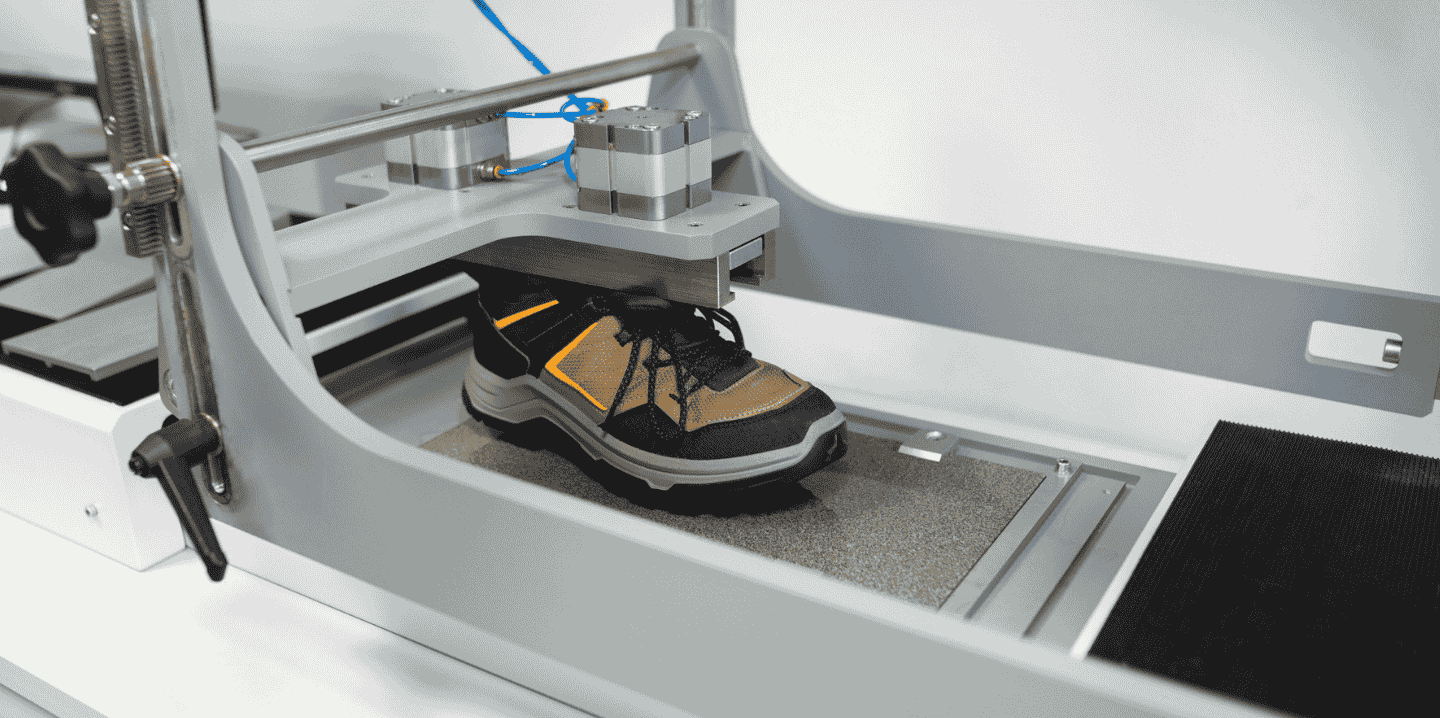The slip resistance test is a fundamental analysis in the footwear industry, used to evaluate the grip of the sole on the walking surface, ultimately reducing the risk of accidental falls due to poor traction. In our laboratory, specialized in footwear testing, we conduct this test according to international standards, providing accurate and reliable data for footwear manufacturers and brands.
Objective of the Slip Resistance Test
The goal of the slip resistance test is to determine the coefficient of friction between the shoe sole and a specific surface, both in dry and wet conditions. This value helps classify footwear in terms of safety and performance, particularly in environments where the risk of slipping is high (e.g., industrial surfaces, healthcare facilities, ceramic or metal flooring).
Reference Standards
Our laboratory performs the test following ISO 13287, one of the most internationally recognized standards for measuring footwear slip resistance.
ISO 13287 Reference Values
- Slip resistance on a flat surface: Minimum coefficient of friction 0.30
- Slip resistance at the rear of the heel: Minimum coefficient of friction 0.28
Limitations of the Standard
- Not applicable to footwear with spikes, metal studs, or similar components.
- Footwear labeled as “slip-resistant” falls under the category of Personal Protective Equipment (PPE).
- The test can also be performed on sole units, outsoles, or other sole components for product development purposes.
Test Procedure
Sample Preparation: before performing the test, the sample is prepared according to a standardized protocol:
- Conditioning: The sample is stabilized in a controlled environment to ensure uniform temperature and humidity conditions.
- Cleaning: The sole is cleaned to remove any impurities that could affect the test results.
- Mounting: The footwear is secured on a specialized platform to ensure the correct application of forces during the test.
Testing Equipment: the test is conducted using a tribometer (or slip resistance measurement device), which evaluates the footwear’s behavior under controlled conditions.
The testing system consists of:
- Test surface (selected based on the product’s application, e.g., ceramic tiles, metal surfaces, etc.).
- Load application device to apply normal force.
- Horizontal motion system to simulate foot sliding on the surface.
Test Execution:
- The sample is placed on the test surface.
- A normal force is applied to simulate the user’s weight:
- 400 N for footwear up to size 39.
- 500 N for footwear size 40 and above.
- The footwear is moved horizontally across the surface (or vice versa) at a controlled speed.
- The test is repeated five times to ensure reliable data.
- The coefficient of friction is measured and recorded for each trial.
Test Conditions:
- Surfaces: The test can be performed on dry or wet surfaces.
- Wet conditions: Water or a detergent solution is used to replicate real-world usage conditions.
- Measurement points: The test is conducted on both the flat part of the sole and the heel area.
Result Interpretation:
After completing the test, data on the dynamic coefficient of friction is collected. If the recorded values meet or exceed the ISO 13287 requirements (≥0.30 for the flat part of the sole, ≥0.28 for the heel), the footwear is considered compliant with minimum slip resistance safety requirements.
If the values fall below the standard, the product may require:
- Sole design modifications (e.g., improving the tread pattern, increasing roughness).
- Use of higher-friction materials.
- Additional testing to optimize performance on specific surfaces.
Importance of the Slip Resistance Test in the Footwear Industry
Conducting slip resistance tests is essential for:
- Ensuring user safety by reducing the risk of accidental falls.
- Improving product quality with concrete data on sole performance.
- Achieving certifications and regulatory compliance, especially for work and sports footwear.
- Supporting research and development by helping manufacturers optimize sole design.
Our slip resistance tests are conducted using advanced equipment, delivering precise results for footwear manufacturers and brands.
If you want to test the slip resistance of your product, contact us by filling out the form at the bottom of the page!

